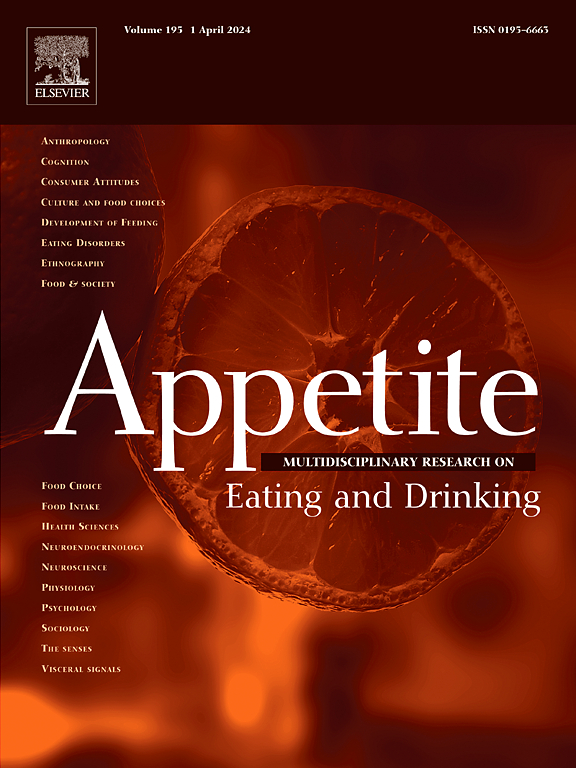不要在吃完零食后检查身体:检查身体会增加与进食有关的威胁感。
IF 3.8
2区 医学
Q1 BEHAVIORAL SCIENCES
引用次数: 0
摘要
目的:参与安全行为可能会加剧饮食失调个体的饮食相关威胁感知和恐惧。本研究通过在非临床女性中操纵与饮食失调相关的安全行为(即身体检查)来测试这一机制。与控制活动相比,进食后的身体检查预计会增加与进食有关的威胁感知和恐惧,减少进食欲望,降低卡路里消耗。方法:99名非临床女性必须吃两种高热量零食,并被随机分配到三个条件之一:在安全行为条件下,参与者测量与饮食失调有关的身体部位,在身体控制条件下,参与者测量与饮食失调无关的身体部位,在一般控制条件下,他们测量家具。在操作之后,参与者再次呈现(类似的)高热量零食,评估他们的恐惧,威胁感知和饮食欲望,并完成一个虚假的味觉测试(随意摄入)。结果:安全行为和身体控制条件的参与者在操作后对食物摄入的感知比操作前更有威胁性。一般对照条件无明显变化。在恐惧、饮食欲望和卡路里消耗方面,不同条件没有显著差异。讨论:检查身体部位——即使只有一次而且与饮食失调无关——会增加非临床女性对饮食相关威胁的感知;为了影响恐惧、饮食欲望和卡路里消耗,可能需要更持久或更强烈的安全行为。本文章由计算机程序翻译,如有差异,请以英文原文为准。
Don’t check after a snack: body checking increases eating-related threat perception
Objective
Engaging in safety behaviours might exacerbate eating-related threat perception and fear in individuals with eating disorders. The present study tested this mechanism by manipulating eating disorder-related safety behaviours (i.e., body checking) in non-clinical women. It is expected that body checking after food intake increases eating-related threat perception and fear, reduces eating desires and lowers calorie consumption compared with control activities.
Method
Ninety-nine non-clinical women had to eat two high-caloric snacks and were randomly assigned to one of three conditions: In the safety behaviour condition they measured body parts related to eating disorder concerns, in the body control condition participants measured body parts unrelated to eating disorder concerns and in the general control condition they measured pieces of furniture. After the manipulation, participants were again presented with (similar) high-calorie snacks, rated their fear, threat perception and eating desires, and completed a bogus taste test (ad-libitum intake).
Results
Participants in the safety behaviour and body control condition perceived food intake as more threatening after the manipulation than before. There was no significant change in the general control condition. Conditions did not significantly differ in fear, eating desires and calorie consumption.
Discussion
Checking body parts – even if it is only once and unrelated to eating disorder concerns - can increase eating-related threat perception in non-clinical women; to also affect fear, eating desires and calorie consumption, more persistent or intense safety behaviours might be necessary.
求助全文
通过发布文献求助,成功后即可免费获取论文全文。
去求助
来源期刊

Appetite
医学-行为科学
CiteScore
9.10
自引率
11.10%
发文量
566
审稿时长
13.4 weeks
期刊介绍:
Appetite is an international research journal specializing in cultural, social, psychological, sensory and physiological influences on the selection and intake of foods and drinks. It covers normal and disordered eating and drinking and welcomes studies of both human and non-human animal behaviour toward food. Appetite publishes research reports, reviews and commentaries. Thematic special issues appear regularly. From time to time the journal carries abstracts from professional meetings. Submissions to Appetite are expected to be based primarily on observations directly related to the selection and intake of foods and drinks; papers that are primarily focused on topics such as nutrition or obesity will not be considered unless they specifically make a novel scientific contribution to the understanding of appetite in line with the journal's aims and scope.
 求助内容:
求助内容: 应助结果提醒方式:
应助结果提醒方式:


